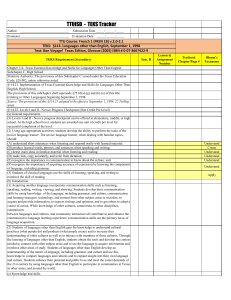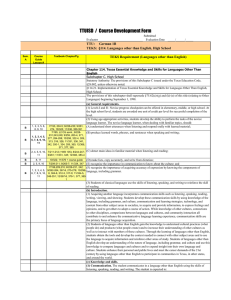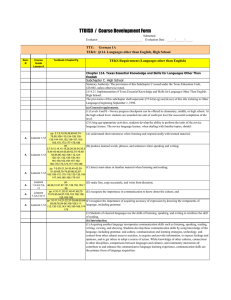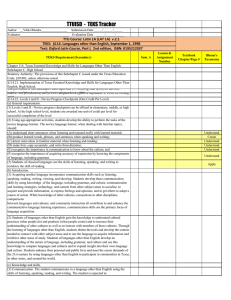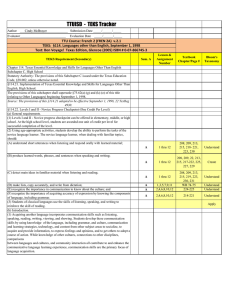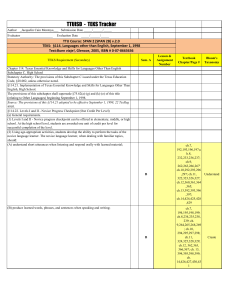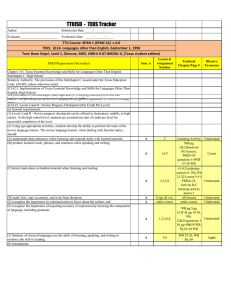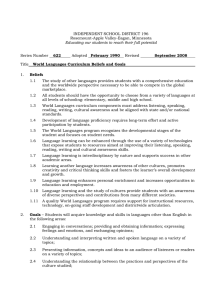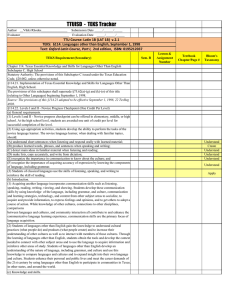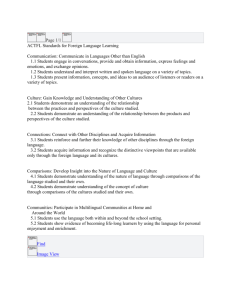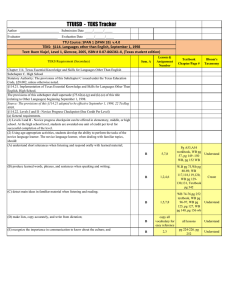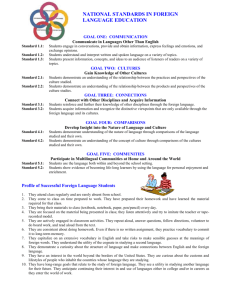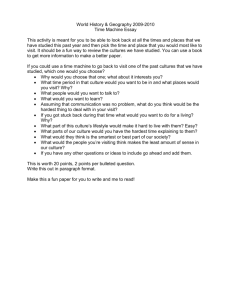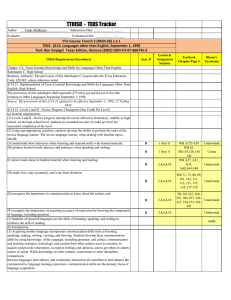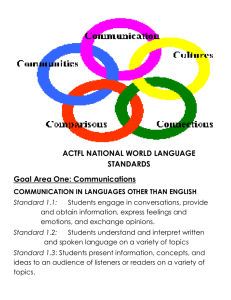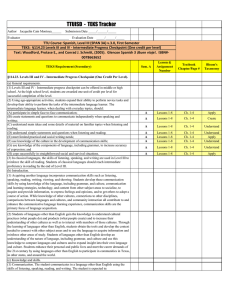Texas Essential Knowledge and Skills- Course TEKS Tracker TEKS Requirement (Secondary)
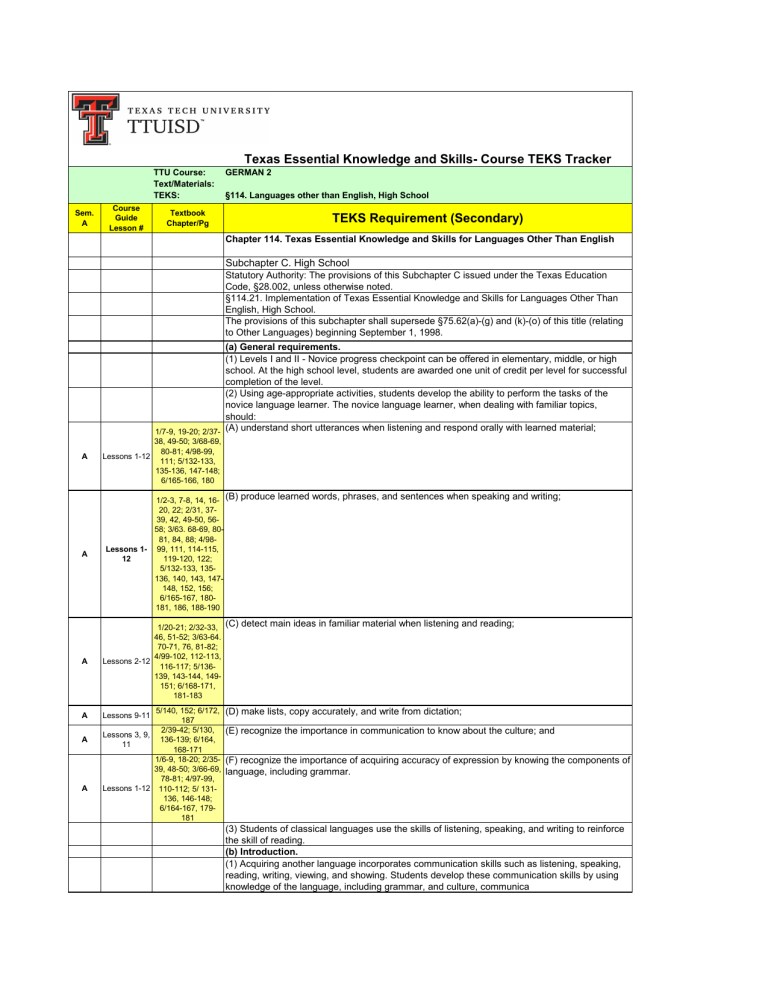
Sem.
A
A
A
A
A
A
A
Course
Guide
Lesson #
TTU Course:
Text/Materials:
TEKS:
Textbook
Chapter/Pg
Texas Essential Knowledge and Skills- Course TEKS Tracker
GERMAN 2
§114. Languages other than English, High School
TEKS Requirement (Secondary)
Chapter 114. Texas Essential Knowledge and Skills for Languages Other Than English
Lessons 1-12
1/7-9, 19-20; 2/37-
38, 49-50; 3/68-69,
80-81; 4/98-99,
111; 5/132-133,
135-136, 147-148;
6/165-166, 180
Subchapter C. High School
Statutory Authority: The provisions of this Subchapter C issued under the Texas Education
Code, §28.002, unless otherwise noted.
§114.21. Implementation of Texas Essential Knowledge and Skills for Languages Other Than
English, High School.
The provisions of this subchapter shall supersede §75.62(a)-(g) and (k)-(o) of this title (relating to Other Languages) beginning September 1, 1998.
(a) General requirements.
(1) Levels I and II - Novice progress checkpoint can be offered in elementary, middle, or high school. At the high school level, students are awarded one unit of credit per level for successful completion of the level.
(2) Using age-appropriate activities, students develop the ability to perform the tasks of the novice language learner. The novice language learner, when dealing with familiar topics, should:
(A) understand short utterances when listening and respond orally with learned material;
Lessons 1-
12
1/2-3, 7-8, 14, 16-
20, 22; 2/31, 37-
39, 42, 49-50, 56-
58; 3/63. 68-69, 80-
81, 84, 88; 4/98-
99, 111, 114-115,
119-120, 122;
5/132-133, 135-
136, 140, 143, 147-
148, 152, 156;
6/165-167, 180-
181, 186, 188-190
(B) produce learned words, phrases, and sentences when speaking and writing;
Lessons 2-12
1/20-21; 2/32-33,
46, 51-52; 3/63-64.
70-71, 76, 81-82;
4/99-102, 112-113,
116-117; 5/136-
139, 143-144, 149-
151; 6/168-171,
181-183
(C) detect main ideas in familiar material when listening and reading;
(D) make lists, copy accurately, and write from dictation;
Lessons 3, 9,
11
Lessons 1-12
2/39-42; 5/130,
136-139; 6/164,
168-171
1/6-9, 18-20; 2/35-
39, 48-50; 3/66-69,
78-81; 4/97-99,
110-112; 5/ 131-
136, 146-148;
6/164-167, 179-
181
(E) recognize the importance in communication to know about the culture; and
(F) recognize the importance of acquiring accuracy of expression by knowing the components of language, including grammar.
(3) Students of classical languages use the skills of listening, speaking, and writing to reinforce the skill of reading.
(b) Introduction.
(1) Acquiring another language incorporates communication skills such as listening, speaking, reading, writing, viewing, and showing. Students develop these communication skills by using knowledge of the language, including grammar, and culture, communica
Sem.
A
A
A
A
A
A
A
A
A
A
A
A
A
Course
Guide
Lesson #
Textbook
Chapter/Pg
TEKS Requirement (Secondary)
Lessons 3,
4, 12
Lessons 2-
12
2/42, 58; 6/185
1/19-20; 2/32-33,
37, 46, 49-52; 3/68-
71, 80, 82-84, 86-
87; 4/94, 98-103,
111-114, 116-119;
5/132-140, 143-
144, 147-152, 154-
155; 6/165-172,
180-189
(2) Students of languages other than English gain the knowledge to understand cultural practices (what people do) and products (what people create) and to increase their understanding of other cultures as well as to interact with members of those cultures
(c) Knowledge and skills.
(1) Communication.
The student communicates in a language other than English using the skills of listening, speaking, reading, and writing. The student is expected to:
(A) engage in oral and written exchanges of learned material to socialize and to provide and obtain information;
(B) demonstrate understanding of simple, clearly spoken, and written language such as simple stories, high-frequency commands, and brief instructions when dealing with familiar topics; and
Lessons 1-4,
6-12
1/12, 20-22; 2/42,
58; 3/84, 88; 4/115,
121, 122; 5/140,
152, 156; 6/172,
190
Lessons 1,
3, 5, 7, 9-12
Lessons 4,
8, 9
1/6, 9-12; 2/34, 39-
41; 3/66; 4/97,
5/130, 136-139,
146; 6/164, 168-
171, 179, 181-183 course guide
(poem); 4/110;
5/130, cooking assignment
(course guide)
(C) present information using familiar words, phrases, and sentences to listeners and readers.
(2) Cultures.
The student gains knowledge and understanding of other cultures. The student is expected to:
(A) demonstrate an understanding of the practices (what people do) and how they are related to the perspectives (how people perceive things) of the cultures studied; and
(B) demonstrate an understanding of the products (what people create) and how they are related to the perspectives (how people perceive things) of the cultures studied.
Lessons 3,
4, 9, 12 see appropriate lessons in course guide
(3) Connections.
The student uses the language to make connections with other subject areas and to acquire information. The student is expected to:
(A) use resources (that may include technology) in the language and cultures being studied to gain access to information; and
Lessons 8,
11
4/116-117; 6/164
(B) use the language to obtain, reinforce, or expand knowledge of other subject areas.
Lessons 1,
3, 9, 11
Lessons 1, 8-
12
1/6; 2/35; 3/78;
5/134; 6/164
1/9; 4/110; 5/136-
138, 146, 150;
6/164, 168-169,
179
(4) Comparisons.
The student develops insight into the nature of language and culture by comparing the student's own language and culture to another. The student is expected to:
(A) demonstrate an understanding of the nature of language through comparisons of the student's own language and the language studied;
(B) demonstrate an understanding of the concept of culture through comparisons of the student's own culture and the cultures studied; and
(C) demonstrate an understanding of the influence of one language and culture on another.
Lessons 3,
9, 12
2/41; 5/139 & course guide
(cooking assignment); 6/179
Lesson 4, 9
Lessons 3,
4, 7, 9 course guide & p.
TE37-38, TE40-41
(Teacher's Edition only)
2/42 (Rollenspiel); course guide
(poetry/music,
Leipzig research & cooking assignments)
(5) Communities.
The student participates in communities at home and around the world by using languages other than English. The student is expected to:
(A) use the language both within and beyond the school setting through activities such as participating in cultural events and using technology to communicate; and
(B) show evidence of becoming a lifelong learner by using the language for personal enrichment and career development.
Source: The provisions of this §114.22 adopted to be effective September 1, 1998, 22 TexReg
4930.
